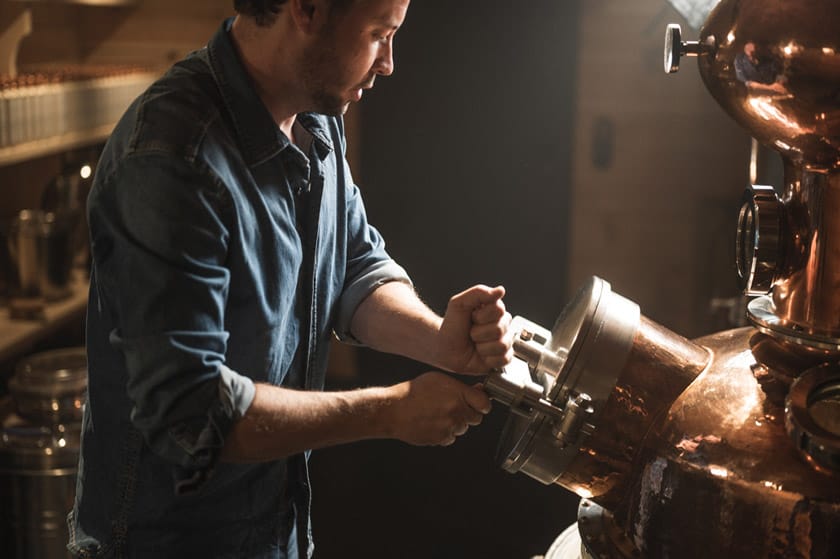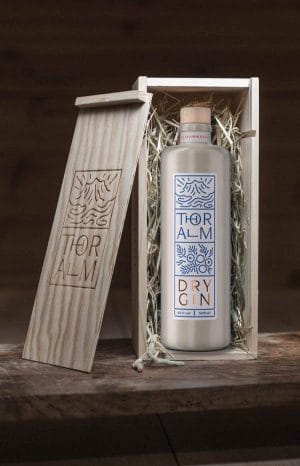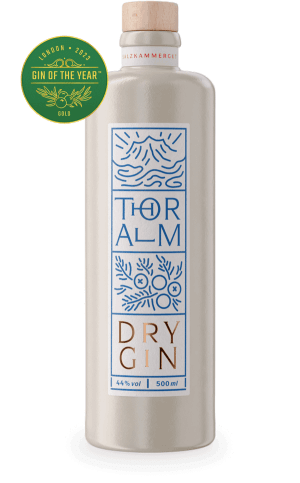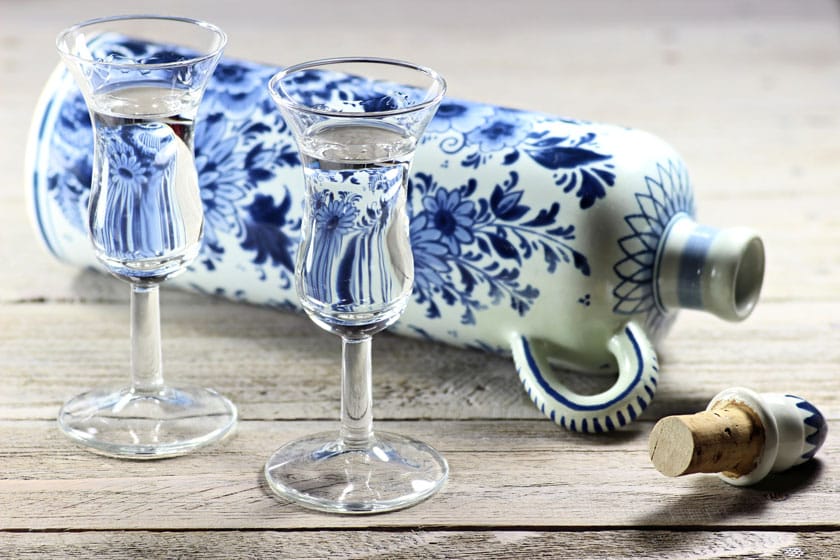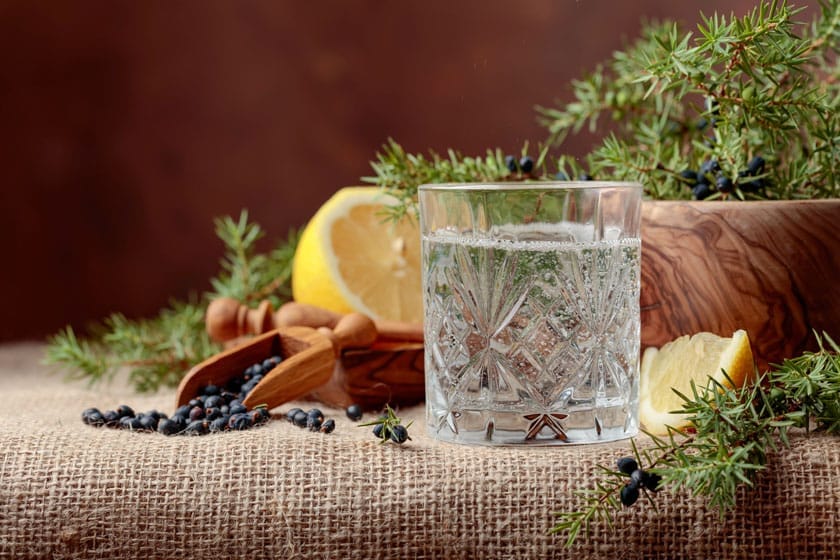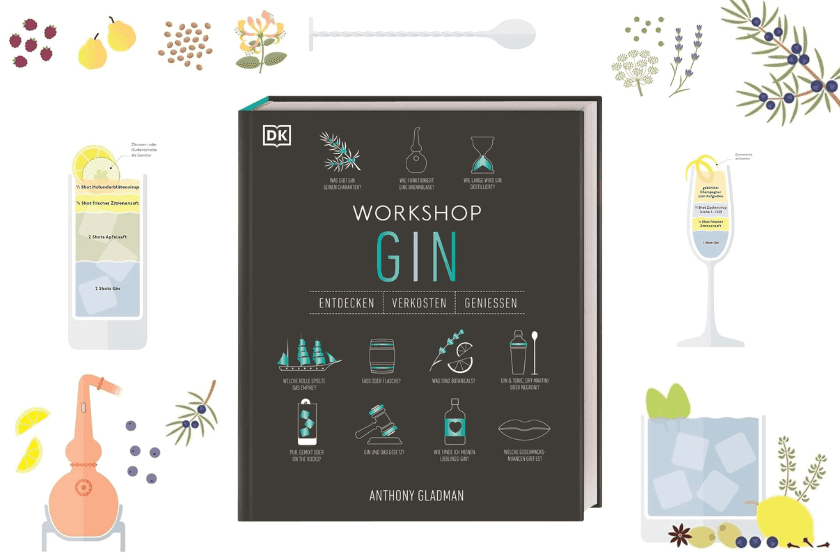Gin, now a staple in bars and cocktail evenings, has a long and fascinating history. Originally developed as genever in the Netherlands, gin reached England in the 17th century and is now very popular around the world. This spirit is characterized above all by its variety of botanicals and the unmistakable aromas of juniper.
Basics of Gin Production
Gin production is based on a careful selection and combination of basic ingredients that result in a complex, aromatic end product. The most important base is a neutral alcohol of agricultural origin. Other essential ingredients are juniper and a variety of other botanicals that give gin its characteristic taste and diverse aroma. Let's look at the basics in detail:
- Neutral alcohol:
The neutral alcohol forms the base of any gin and acts as a carrier for the flavors of the botanicals. This alcohol is often made from agricultural products such as grains or potatoes, but sometimes from sugar beet or other raw materials. The distillation process ensures that unwanted flavors are removed, resulting in a flavorless alcohol that can easily absorb the flavors of the botanicals. In Europe, this base alcohol must have a minimum of 96% alcohol content before it is diluted with water to the desired level. - Juniper:
The berries of the juniper bush are the heart of every gin and have a decisive influence on its taste profile. Juniper berries give the gin its characteristic, slightly resinous and spicy aroma. In fact, the EU regulation requires that juniper must be the dominant flavor note of a gin in order to be called such. Depending on the type of gin, the juniper berries can be more or less pronounced. For example, juniper plays a stronger role in a London Dry Gin than in modern variants that focus more on exotic botanicals. - Botanicals:
Besides juniper, the other botanicalsthat make each gin unique. These botanical ingredients can consist of a variety of herbs, spices, seeds, fruits and roots. Commonly used botanicals are:- Coriander seeds: Provides spicy, slightly peppery notes.
- Angelica: Adds earthy, warm flavors.
- citrus peels: Give the gin fresh, citrus notes.
- Cardamom: Contributes to a spicy, slightly sweet taste.
- Lavender: Gives the gin floral notes.
- Cinnamon: For a sweet and spicy touch.
The selection and combination of botanicals are crucial to the aroma, taste and uniqueness of a gin. Some modern producers experiment with exotic ingredients such as cocoa nibs, hibiscus flowers or pepper to make their gin innovative and individual. However, the perfect balance of botanicals is crucial, as an excess of one ingredient can easily dominate and affect the taste.
methods of gin production
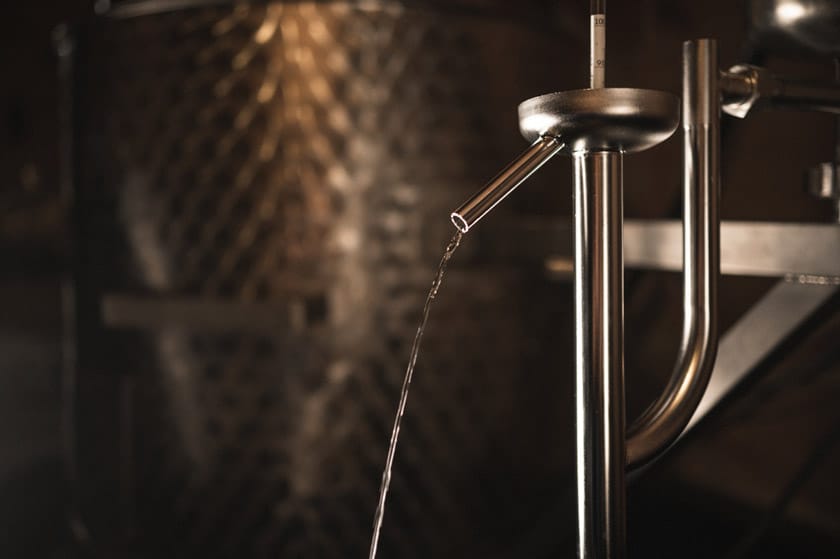 Making gin requires a thorough knowledge of the different methods used to transfer the aromas of the botanicals into the neutral alcohol. Each method offers unique advantages and contributes to the characteristic flavor development. The three main processes used in gin production are maceration, percolation and distillation. Each method has its specific characteristics that lead to the differences in flavor and complexity.
Making gin requires a thorough knowledge of the different methods used to transfer the aromas of the botanicals into the neutral alcohol. Each method offers unique advantages and contributes to the characteristic flavor development. The three main processes used in gin production are maceration, percolation and distillation. Each method has its specific characteristics that lead to the differences in flavor and complexity.
- Maceration:
Maceration involves soaking the botanicals - which include juniper and other herbs, spices and fruits - directly in neutral alcohol. During this process, the aromatic compounds from the ingredients are extracted by the high alcohol concentration and absorbed by the alcohol. The maceration process can take hours, days or even weeks, depending on the desired flavors and their intensity. This technique makes it possible to create a deep, rich flavor profile, especially when the botanicals are macerated for a longer period of time. It is particularly well suited to complex botanicals such as roots, seeds or barks that take longer to release their essence. - Percolation:
Percolation involves heating the alcohol to create the vapor, which is then passed through a network of botanicals. This causes the botanicals' aromas to dissolve in the alcohol vapor, which is then condensed and collected. This method is well suited to delicate botanicals such as flowers or citrus peels, which can lose flavor when in direct contact with alcohol or when macerated for a long time. The advantage of this method is that the aromas are treated more gently, as they are extracted more gently through the steam line. This results in lighter, more subtle flavors in the finished gin. - Distillation process:
- Pot still distillation: In this method, the flavoured alcohol is heated in copper stills (pot stills). The alcohol evaporates and then condenses in a cooler to form an aromatic distillate. Pot still distillation is done in batches, which allows for greater control over the distillation process and the ability to achieve different levels of flavour. This often results in a richer and more complex flavour profile as the copper stills have a natural influence on the aromatic quality of the gin.
- Column distillation: In a continuous process, the alcohol evaporates and condenses in a distillation column. This method is used to obtain a very pure and neutral alcohol that serves as a base for flavoring with botanicals. Column distillation allows for very precise control of the distillation process and produces an alcohol with a higher degree of purity, resulting in a cleaner, clearer gin.
Each method of gin production has its own advantages and imparts different nuances to the final product. Distilleries often combine different techniques to achieve an optimal flavour profile. For example, a gin that has been enriched through maceration may then be further refined through percolation and a pot still distillation. This creates an incredible variety of flavours and textures that make gin one of the most diverse spirits in the world.
Maturation and storage
The maturation and storage of gin are crucial aspects that can have a significant impact on the quality and flavour profiles of the final product. Although gin is not generally known for maturation like other spirits such as whisky or rum, there are methods and techniques used by some producers to further develop and refine the flavours.
Importance of Storage
Traditionally, gin is bottled and sold immediately after distillation to preserve its clean and fresh botanical flavours. This immediate bottling ensures the intensity and freshness of the various botanical ingredients, from juniper to citrus and herbs. However, some modern distilleries are experimenting with storage methods to expand their product range and offer special gins with unique characteristics.
Experimental maturation
Some producers use wooden barrels to age their gin, similar to the method used in the production of whisky or brandy. This approach can have different effects on the aroma and flavour of the gin, depending on the type of wood, the pre-treatment of the barrels and the length of time it is stored. For example, barrels that have previously been used to age sherry, port or even whisky can add additional flavour nuances to the gin, from sweet and fruity notes to richer, woodier undertones.
influence of ripening time
The length of storage can also have a significant impact on flavour development. Short storage times allow subtle wood notes and a slight complexity to be added without masking the typical gin flavours. Longer storage times, on the other hand, can result in the gin developing deeper, rounder and often more complex flavour profiles reminiscent of classic dark spirits. These aged gins offer a completely new experience for gin lovers and are particularly well suited to being enjoyed neat or in cocktails that require a fuller, richer spirit character.
Modern Approaches and Trends
In addition to using wooden barrels, some producers are also exploring other innovative storage methods, such as using steel tanks or ceramic containers that allow for other types of interactions between the gin and the storage medium. These methods can preserve the purity and clarity of the gin, while allowing for gentle maturation that accentuates certain flavors.
Gin varieties and their flavors
Gin is growing in popularity and can be made in a variety of styles and flavor profiles. Each variety has its distinctive characteristics, influenced by the botanicals used, the distillation method and possible maturation processes. Below is a detailed description of the common types of gin and their flavors:
- London Dry Gin
London Dry Gin is probably the best known and most popular variant. This style is characterized by its dry character and the intense juniper note, which must be in the foreground. According to EU regulations, London Dry Gin may only be enriched with natural flavors (botanicals) during distillation and no added sugar is allowed. The typical clarity and purity of this gin makes it perfect for classic cocktails such as Martini or gin and tonic. In addition to the dominant juniper, citrus peel, coriander seeds and angelica root often give this gin additional nuances. - Old Tom Gin
Old Tom Gin is a historical variant that has recently become popular again. It was particularly popular in Great Britain in the 18th and 19th centuries and was traditionally made with a slight sweetness. This was achieved by adding sugar or other sweeteners. Old Tom Gin therefore has a milder, more rounded flavor than the dry London Dry Gin. The slight sweetness gives it a special depth, which is ideal for cocktails such as the Tom Collins or Martinez. The botanicals and juniper profile are less intense than other varieties, resulting in a smooth and balanced blend. - New Western Gin
The New Western Gin (also called New American Gin) is a modern interpretation of the traditional recipe. In this variant, the juniper flavor takes a back seat to make room for other botanicals. This creates innovative flavor profiles that emphasize exotic and local ingredients. Botanicals such as lavender, hibiscus, ginger or fruit are often used to create a floral, spicy or fruity note. The New Western Gin offers a wide range of flavors that reflect the creativity of modern gin producers and is suitable for experimental cocktails and new taste experiences. - Reserve Gin
Reserve gin is a variant similar to aged spirits such as whiskey. This variety is aged in wooden barrels for a period of time after distillation to develop additional complexity and depth of flavour. The barrels used may have previously contained other spirits such as whiskey, rum or brandy and give the gin various flavour nuances, from vanilla and caramel to spicy, woody notes. The ageing also provides a distinctive colour, which ranges from light gold to amber depending on the length of the process. Reserve gin is great for enjoying neat or in cocktails that benefit from its rich variety of flavours.
quality control and expertise
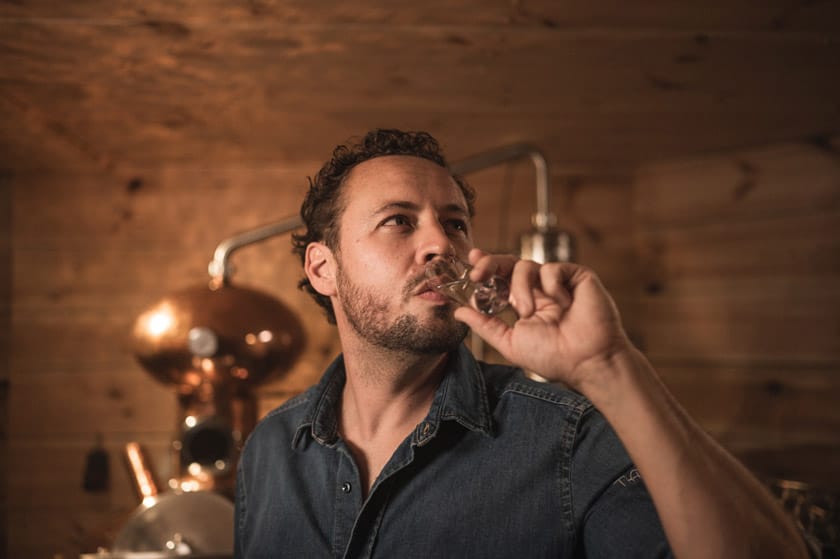
The production of a high-quality gin requires careful monitoring of every step in the production process. This begins with the selection of raw materials and ends with the final bottling. The role of the master distiller is crucial, as his experience and expertise significantly influence the quality and uniqueness of the finished product.
The Role of the Master Distiller
The Master Distiller oversees and coordinates the entire production process. This role is comparable to that of a chef who carefully selects the ingredients and masterfully controls their combination. The Master Distiller must have a deep understanding of the properties of each individual botanical and know how they interact in the distillation process. He is responsible for the recipe of the gin, the selection and mixing of the botanicals, the control of the distillation and often also for the innovation of new types of gin. His goal is to create a gin that not only tastes good but also stands out in its category.
criteria for high-quality gin
To be considered high quality, gin must meet various criteria:
- Clear aroma: High-quality gin should have a clean and clear aroma that is free of unwanted odors. The freshness of the botanicals and the purity of the alcohol used play a crucial role here.
- Balanced botanicals: The balance and harmony of the botanicals are crucial to the quality of the gin. Each botanical should contribute its part to the overall aroma without overpowering the others. The master distiller must have a keen sense of how the different ingredients should be combined to create a well-rounded and complex flavor profile.
- Complex but harmonious taste: A high-quality gin is characterized by a complexity that develops different flavors while drinking. However, this complexity should not be confusing, but rather result in a harmonious overall impression that makes the gin enjoyable both in cocktails and neat.
- Consistency: The ability to ensure consistent quality across different production batches is another hallmark of high-quality gin. This requires precise control and standardized processes in distillation and bottling.
Modern technologies and traditional craftsmanship
To meet quality standards, many distilleries combine traditional craftsmanship with modern technologies. The use of computer-controlled distillation equipment allows precise control of temperatures and pressures during distillation, which contributes to the consistency and quality of the final product. At the same time, many master distillers preserve traditional methods and techniques that have been proven over generations to guarantee the characteristic taste and depth of the gin.
Gin production at THORALM: A sip of peace, perfectly distilled

Gin production at the Thoralm combines traditional craftsmanship, regional ingredients and a deep connection with nature. The Thoralm is located in the Salzkammergut, a beautiful alpine region at an altitude of 1,400 meters, where cultural landscapes have been cultivated and agricultural products processed with great care since 1740. Rooted in this tradition, the THORALM manufactory relies on regional ingredients and a loving, artisanal production method for its gin.
Unique ingredients and distillation processes
The THORALM Dry Gin is made exclusively from seven alpine herbs that grow in the area around the Thoralm. These herbs include mountain juniper, tormentil, ribwort, yarrow, nettle, lemon balm and red clover. These botanicals give the THORALM Gin a unique taste profile that makes it immediately recognizable. The taste aims to reflect the purity of nature and the simplicity of alpine life - calm, close to nature and reduced to the essentials.
In order to bring out the natural aromas of the local botanicals in the best possible way, THORALM Dry Gin is produced in a specially made 125-litre pot still. This traditional copper still was specially developed for the needs of the factory. It makes it possible to work without modern aids such as aroma baskets or columns and to carry out the distillation using the purest, most original method. The mountain spring water, which comes from the company's own spring in the limestone mountains of the Postalm massif, is particularly rich in minerals and is original.
Highest quality through handcraft and regionality
The production is done entirely by hand and relies on regional materials. The wooden boxes for the gin are made by a wood manufacturer in nearby Abtenau, the copper still comes from a blacksmith in Tyrol and the bottles and corks are also made regionally. This care in selecting suppliers ensures an authentic, high-quality product that reflects the region.
Storage and Presentation of Gin
A proper storage and an appealing presentation are essential aspects to preserve and enjoy the quality and taste experience of gin.
storage
- Cool, dark place:
Gin should always be stored in a cool, dark place. Light and heat can affect the aromas and change the taste. A pantry or wine cellar are ideal places to store the bottles and maintain the freshness of the botanicals. - Correct closure method:
The bottle cap should be tight to prevent air from entering and the alcohol from evaporating. This ensures that the aromas are preserved for a long time. Gins with a natural cork as a closure should be stored upright to prevent the cork from drying out. - Storage period:
Gin has a long shelf life due to its high alcohol content. Even after opening, it can remain drinkable for several years as long as it is properly sealed and stored in a place protected from light. However, storing it for too long over many years can affect the taste as the alcohol content decreases.
presentation
- Selection of glassware:
Presenting gin starts with choosing the right glass. A classic tumbler or highball glass is ideal for cocktails such as Gin Tonic, while a martini or coupe glass is used for elegant, pure cocktails like the martini. A bulbous copa glass can bring out the aromas particularly well. - Garnishes and ice cream:
Choosing the right garnish helps to bring out the flavor of the gin. Lemon or orange slices, cucumber, berries or herbs can refine the aroma and give the drink an individual touch. The quality of the ice also plays a role: Clear, large ice cubes melt more slowly and dilute the gin less. - Serving ideas:
A gin tasting can be an exciting experience, sampling different gins with different garnishes and cocktails, allowing guests to experience the variety of flavours and learn which botanicals make up their preferred taste.
Conclusion
The production of gin is a fascinating symbiosis of science and art. Neutral alcohol, juniper and a wide range of carefully selected botanicals form the basis for a spirit that is hard to beat in its diversity. Each distillery has its own methods and philosophies, resulting in an astonishing range of varieties and flavor profiles - from classic and juniper-focused to exotic and modern.
Whether London Dry, Old Tom, New Western or Reserve Gin - each variant has its own history and identity. Through the skilful use of different distillation methods, the balance of botanicals and innovative maturation techniques, manufacturers succeed in creating unique gins that captivate connoisseurs. With the diverse aromas and styles, there is something to discover for every taste.
-

DRY GIN in gift box 500ml
72,00 €14,40 € / 100 ml
incl. 20% VAT
plus shipping costs
Product contains: 500 ml
Add to cart -

THORALM DRY GIN 500ml
59,90 €11,98 € / 100 ml
incl. 20% VAT
plus shipping costs
Product contains: 500 ml
Add to cart -

THORALM DRY GIN 6 x 500ml
339,40 €11,31 € / 100 ml
incl. 20% VAT
plus shipping costs
Product contains: 3000 ml
Add to cart
FAQ on Gin Production
How is gin made?
Gin is made by flavoring a neutral alcohol with juniper berries and various botanicals. It is then distilled to extract the flavors and achieve the desired taste.
What ingredients are used for gin?
The main ingredients are a neutral alcohol, juniper berries and various botanicals such as coriander, citrus peel, herbs and spices, which give the gin its characteristic aroma.
What distillation methods are used in gin production?
The most common methods are maceration (soaking the botanicals in alcohol), percolation (passing alcohol vapor through the botanicals) and pot still distillation (batch distillation in copper stills).
What makes a high-quality gin?
A high-quality gin is characterized by a balanced combination of botanicals, a clear taste without unwanted side flavors and careful distillation that brings out the aromas harmoniously.
What role does juniper play in gin?
Juniper is the central botanical in gin and gives it its characteristic, spicy aroma. According to EU regulations, juniper must be the dominant flavor note of a gin.
Can you make gin at home?
Making gin at home is heavily regulated in many countries and often only permitted with special licenses. It also requires knowledge of distillation and the safe handling of alcohol.
What is the difference between London Dry Gin and other types of gin?
London Dry Gin is known for its dry taste and strong juniper notes. In contrast, other varieties such as Old Tom Gin can be sweeter or New Western Gin can emphasize exotic botanicals more.
What is the alcohol content of gin?
Gin usually has an alcohol content of between 40% and 47% vol. In Europe, the base alcohol must be at least 96% vol. before dilution. Our THORALM Dry Gin has an alcohol content of 44%.
How do botanicals influence the taste of gin?
The selection and combination of botanicals determine the flavor profile of the gin. Different herbs, spices and fruits can add fresh, spicy, floral or fruity notes.
How long does it take to make gin?
The entire manufacturing process can take from a few days to several weeks, depending on the method of flavoring and distillation and the desired flavor profiles.
